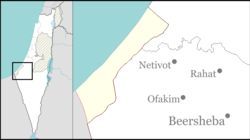Beit Kama
Beit Kama
בֵּית קָמָה بيت كاما | |
|---|---|
 | |
| Coordinates: 31°26′44″N 34°45′38″E / 31.44556°N 34.76056°E | |
| Country | |
| District | Southern |
| Council | Bnei Shimon |
| Affiliation | Kibbutz Movement |
| Founded | 18 April 1949 |
| Founded by | Hashomer Hatzair members |
| Population (2022)[1] | 1,426 |
| Website | www |
Beit Kama (Hebrew: בֵּית קָמָה, lit. House of Standing Grain) is a kibbutz in the northern Negev desert in Israel. Located north of the Bedouin city of Rahat, it falls under the jurisdiction of Bnei Shimon Regional Council. In 2022 its population was 1,426.[1]
History
[edit]The kibbutz was founded on 18 April 1949, south-east of the Palestinian village al-Jammama, which had been depopulated on 22 May 1948 during the 1948 Arab–Israeli War.[2] The founders of Beit Kama were immigrants from Hungary who belonged to Hashomer Hatzair movement.[citation needed]
The settlement was initially called "Safiach", but later became Beit Kama, a name derived from Isaiah 17:5: "And it shall be as when the reaper gathers standing grain."[3]
Beit Kama is a secular kibbutz affiliated with HaKibbutz HaArtzi and Hashomer Hatzair.[citation needed]
Economy
[edit]
Kamada, a plasma-derived biopharmaceutical company, was established in Beit Kama in 1990. Its first product was human albumen.[4] Kamada's production facilities are located on the kibbutz.[5]
Archaeology
[edit]In 2013, archaeologists of the Israel Antiquities Authority discovered a Byzantine era mosaic floor on the grounds of the kibbutz. The red, black, and yellow mosaic is decorated with images of birds, local flora and geometrical designs. An ancient water system with pools and channels was also unearthed.[6]
References
[edit]- ^ a b "Regional Statistics". Israel Central Bureau of Statistics. Retrieved 21 March 2024.
- ^ Morris, B. (2004). The Birth of the Palestinian Refugee Problem Revisisted. Cambridge University Press. pp. xxii, no. 167. ISBN 978-0-521-00967-6.
- ^ Carta's Official Guide to Israel and Complete Gazetteer to all Sites in the Holy Land. (3rd edition 1993) Jerusalem, Carta, p.113, ISBN 965-220-186-3 (English)
- ^ Kamada Milestones
- ^ Israeli Company Kamada Breaks Ground with Promising COVID-19 Treatment
- ^ Byzantine era mosaic floor found on Negev kibbutz The Jerusalem Post, 5 December 2013


